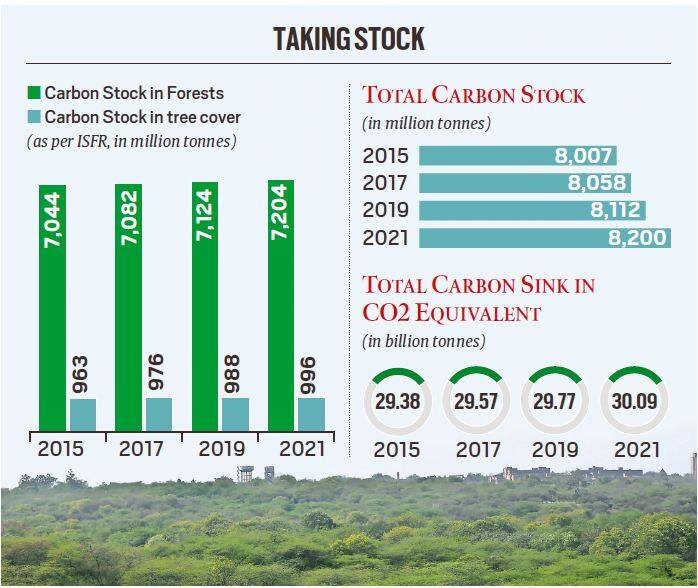Description

Disclaimer: Copyright infringement not intended.
Context: India is committed to increase its carbon sink by 2.5-3 billion tonnes of CO2 equivalent by 2030, but it has not formally submitted to the UNFCCC the clarification that the baseline year for this would be 2005. Despite this seeming ambiguity, the target is within reach.
Details:
Background:
- When India updated its international climate commitments — first made in 2015 in the run-up to the Paris climate conference — in August last year, it enhanced two of the three original targets it had promised to achieve by 2030.
- It said it would reduce the emissions intensity of its economy — emissions per unit of GDP — by 45 per cent from 2005 levels instead of the 33 to 35 per cent promised earlier.
- And that it would ensure that renewables formed at least 50 per cent — up from the original 40 per cent — of its total installed electricity generation capacity.
- The third target — a commitment to increase its carbon sink by 2.5 to 3 billion tonnes of carbon dioxide equivalent by 2030 through the creation of additional forest and tree cover — was left untouched.
- A year earlier too, when Prime Minister spoke about India’s five-point “Panchamrit” action plan at the Glasgow climate meeting in 2021, there had been no mention of this third commitment.

Disclaimer: Copyright infringement not intended.
Present status:
- Since 2015, the carbon sink in the country — which is the total amount of carbon dioxide absorbed by and residing in forests and trees — had increased by 703 million tonnes of CO2 equivalent, or roughly by 120 million tonnes every year.
- At this pace, the target of 2.5 to 3 billion tonnes of CO2 equivalent was unlikely to be met by 2030.
.jpeg)
Ambiguities:
- The carbon sink target had not been defined precisely in 2015.
- India had committed “to create an additional carbon sink of 2.5 to 3 billion tonnes of CO2 equivalent through additional forest and tree cover by 2030”, but it had made no mention of the baseline year.
- By contrast, India’s target on emissions intensity specified 2005 as the baseline year. And the commitment on renewable capacity did not require a baseline because it was an absolute target.
- Forest Survey of India (FSI) pointed out that even the word “additional” in the Indian commitment could be interpreted in different ways. So, “additional carbon sink” could mean
- over and above the carbon sink that existed in the baseline year, or
- over and above what it would be in the target year of 2030 in the business-as-usual scenario.
- India’s forests and tree cover had a carbon sink of 29.38 billion tonnes of CO2 equivalent in 2015, and this was projected to increase in a business-as-usual scenario — that is, without the intervention of any fresh effort — to 31.87 billion tonnes in 2030, according to the FSI analysis.
Resolving Ambiguities:
- Last year, the government appeared to remove the ambiguity regarding the baseline year for the carbon sink target by committing itself to the baseline of 2005.
- In a written reply to a Parliament question, Environment said, “India had already achieved 1.97 billion tonnes of additional carbon sink as compared to the base year of 2005.” He added that “the remaining target can be achieved by increasing forest and tree cover of the country through implementation of various central and state sponsored schemes”.
- The statement in Parliament also seemed to settle the question of additionality flagged by the FSI analysis. The promised addition to carbon sink would have to be measured against what existed in the baseline year (2005) and not what it was projected to be in the target year (2030) in the business-as-usual scenario.
|
PRACTICE QUESTION
Q) Discuss the various ambiguities related to India’s carbon sink target. (150 words)
|

https://indianexpress.com/article/explained/explained-climate/meeting-indias-carbon-sink-target-co2-emission-paris-climate-conference-8484854/












